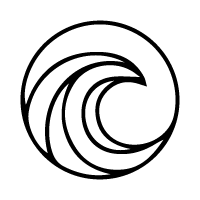Introduction: Choosing the Best Beginner Surfboard
Beginning your surfing adventure starts with one key decision – selecting the right surfboard. For beginners, this isn't just about choosing a board; it's about finding a partner for your sea adventures, a companion that complements your growing skills and fosters your love for the sport.
Surfing is an art, a dance with the ocean. As a beginner surfer, your surfboard is more than mere equipment; it’s your initial instructor. It's a guide that introduces you to the waves, teaching balance, and building the confidence necessary to navigate the ocean's rhythm.
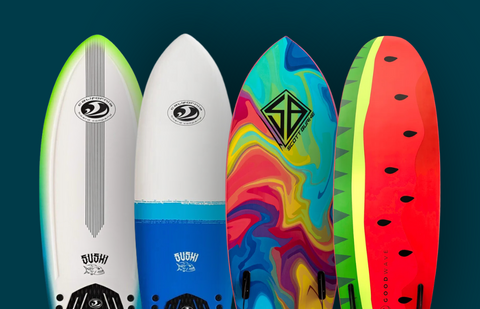
Selecting the perfect beginner surfboard involves matching the board with your aspirations, physique, and the waves you intend to ride. Choosing the right surfboard sets the foundation for your surfing journey, ensuring progress and enjoyment in harmony with the sea.
This guide delves into the best beginner surfboards of 2024, showcasing options like soft top surfboards, favored for their forgiving nature, which is crucial for beginners. Whether it's a foam surfboard for its buoyancy or a longboard for its stability, the key is finding a board that resonates with your beginner status yet accommodates your growth in the sport.
Remember, the right beginner surfboard shapes your surfing journey, potentially sparking a lifelong passion for the sport. As you explore options, consider not just the size and shape, but also the construction, materials, and suitability for your skill level.
Essentials of Beginner Surfboards
When stepping into the surfing experience, choosing your first surfboard is critical. Here, we'll explore the essential characteristics that define the best beginner surfboards, ensuring you make an informed choice that sets the stage for your surfing journey.

Key Characteristics of Beginner Surfboards
- Stability:
- A stable surfboard is foundational for beginners. It provides the necessary balance and support for those initial attempts at standing and riding waves.
- Look for boards with a wide surface area, as they offer increased stability.
- Buoyancy:
- High buoyancy is crucial for ease in paddling and wave catching. It allows the board to float better, making it simpler to handle in the water.
- Boards with more volume, usually wider and thicker, are typically more buoyant.
- Ease of Use:
- A beginner surfboard should be straightforward to maneuver, both while paddling out and riding waves.
- Options like longboards and foam surfboards are often recommended for their user-friendly nature.
The Right Surfboard: The Best Ally of a Beginner Surfer
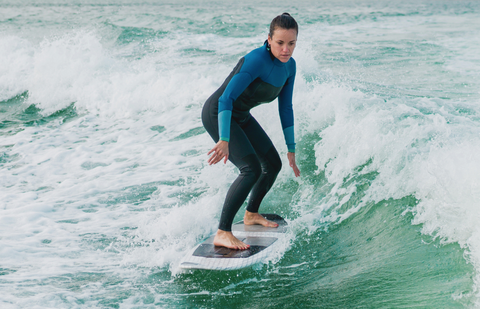
A good surfboard makes learning to surf much easier for beginners. Selecting a surfboard tailored to your needs is crucial; it transforms the initial challenges into enjoyable milestones.
Picking a board that suits you well is important. It helps make your first surfing experience easier and more fun. Beginner surfboards are always made with new surfers in mind. They meet the requirements of someone just starting. This careful design lets new surfers focus on getting better and enjoying the waves, instead of struggling with the wrong gear.
Choosing a surfboard that provides stability, buoyancy, and ease of use doesn't just improve your first surfing experience. It builds a solid base for your growth and progress in surfing.
Materials Matter: Epoxy vs. PU Surfboards
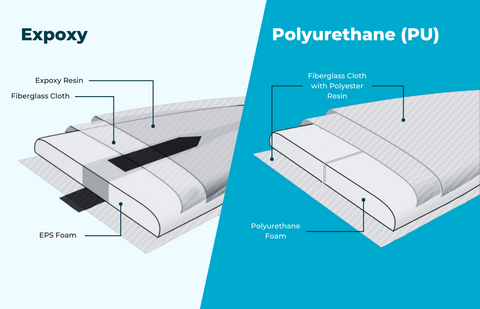
When it comes to beginner surfboards, the material they're made of is really important for how they perform and fit. The two main materials are Epoxy and Polyurethane (PU), and each has its special features and advantages. Knowing how these materials are different is important for picking the best beginner surfboard.
Epoxy Surfboards
- Epoxy boards are known for their lightweight nature, making them easier to handle, both in and out of the water. This feature is particularly beneficial for beginners who are still learning to maneuver their boards.
- The durability of Epoxy is also a significant advantage. These boards are less prone to dings and damage compared to their PU counterparts.
- Epoxy surfboards offer increased buoyancy, which is a crucial factor for beginners. The extra floatation aids in easier wave catching and provides more stability while standing up.
- This buoyancy also translates to better paddling efficiency, allowing beginners to catch more waves with less effort.
Polyurethane (PU) Surfboards
- PU surfboards are known for their traditional flex and feel in the water. This material offers a different surfing experience, with a sensation that many surfers appreciate.
- However, PU boards are generally heavier than Epoxy, which can be a consideration for beginners in terms of handling.
- PU surfboards require more maintenance due to their susceptibility to dings and water absorption. This aspect might be a drawback for beginners not yet accustomed to regular surfboard maintenance.
Suitability of Epoxy Boards for Beginners
When a person begins their search for a new board, especially when learning how to surf, a soft top surfboard is often a good option. Epoxy boards are particularly suitable for beginners due to their construction. They are easy to paddle, less likely to break, and great for riding waves. These features make Epoxy boards a preferred choice for families and individuals just starting their surfing journey.
- Given their lightweight nature, durability, and extra buoyancy, Epoxy surfboards stand out as the more suitable choice for beginners.
- The ease of use, lower maintenance requirements, and forgiving nature of Epoxy make them ideal for those just starting surfing.
- Beginners will find that Epoxy boards offer a more comfortable learning curve, helping them build confidence and skills more efficiently.
While both Epoxy and PU surfboards offer unique benefits, Epoxy boards are usually more suitable for beginners. They are durable, buoyant, and easy to use, which is great for people new to surfing. When you start surfing, it's just as important to think about what your surfboard is made of as its shape and size. An Epoxy board might be what you need for a more fun and successful start in this sport.
Longboards: A Beginner's Best Friend
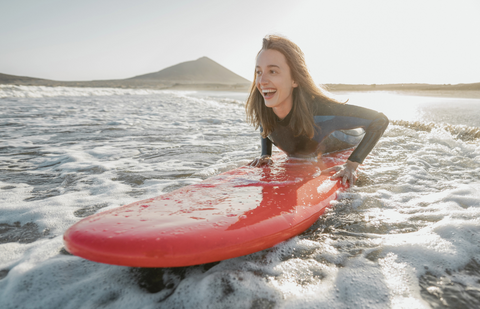
Longboards are often a great choice for beginners, especially for families and kids just starting to catch waves. Their construction and range of features align well with the needs of someone learning to surf, making them a good option to ease into the sport. These boards generally offer more float and stability, which can be in the best interest of anyone new to the sport.
Why Longboards are Ideal for Beginners
- Longboards, typically ranging from 8 to 11 feet, offer unparalleled stability due to their size and volume. This stability is crucial for beginners who are still developing their balance and control of the water.
- Their large surface area provides a forgiving platform for new surfers to stand up and maintain their balance, making the initial learning process smoother.
- The buoyancy of longboards makes paddling and wave-catching significantly easier. For beginners, catching waves and getting enough momentum to stand up can be challenging, and the buoyancy of longboards alleviates this issue.
- The size of longboards also means they don't require big waves to get moving, allowing beginners to practice in smaller, more manageable waves.
- Longboards are not just for the initial stages of learning; they also provide ample room for skill development. As beginners gain confidence, they can experiment with basic maneuvers and techniques.
- The forgiving nature of a longboard allows a beginner to focus on their stance, paddling technique, and wave timing without the added difficulty of managing smaller boards.
Transitioning to Other Board Types
Starting with a longboard is often the best decision for a beginner surfboard. It helps in learning how to surf and is easier to paddle. As one gets better at riding waves, though, moving to smaller boards can be a better option to get the most out of your surfing experience. Think of different surfboards for different levels. For example, soft top surfboards are great for beginners, but might not be what intermediate or expert surfers are looking for.
- While longboards are excellent for beginners, they also pave the way for transitioning to other types of surfboards. As skills and confidence grow, surfers can explore shorter boards or different styles, like fish boards or funboards, which offer different surfing experiences.
- The mastery of longboarding skills lays a solid foundation for handling various wave conditions and board types, making the transition to different surfboards more intuitive and less daunting.
The Soft Top Advantage for New Surfers

As beginners start their surfing adventure, soft-top surfboards stand out as an excellent choice. Known for their user-friendly features, soft top boards offer several advantages that cater specifically to the needs of new surfers.
Benefits of Soft Top Surfboards for Beginners
- Soft top surfboards are well-known for their safety, thanks to the soft foam construction. This feature is particularly beneficial for beginners who are more prone to falls and collisions.
- The soft surface provides a more comfortable platform, reducing the risk of injuries and making the learning process more enjoyable.
- These boards are highly durable and can withstand the typical knocks and bumps that occur during the learning process.
- Their maintenance needs are minimal, offering a hassle-free experience for beginners who might not be familiar with surfboard care.
- The design of soft top surfboards usually includes a wide shape and substantial volume, contributing to greater stability in the water – a key factor for new surfers.
- They are also easier to paddle and catch waves with, which is essential for beginners to get more practice and improve their skills.
Ideal Conditions for Soft Top Surfboards
Soft top surfboards are great for beginners learning to surf. They are best used in small to medium waves, which are ideal for new board users. The soft construction of these boards helps beginners catch surf easily. They provide a stable platform for learning how to paddle and ride waves.
- Soft tops are particularly well-suited for small to medium waves, typical conditions where beginners start their surfing journey.
- The forgiving nature of these boards in such conditions allows for a more focused learning experience on wave timing, paddling technique, and basic maneuvers.
Transition to Traditional Surfboards
- As beginners progress, soft top surfboards can serve as a stepping stone towards more traditional surfboards.
- The skills and confidence gained from using a soft top can be seamlessly transferred to other types of boards as surfers advance in their abilities.
Soft top surfboards, with their blend of safety, ease of use, and durability, provide an ideal starting point for beginners. They not only make the initial steps into surfing more accessible but also ensure a safer and more enjoyable learning curve.
Top 10 Beginner Surfboards of 2024
1. CBC 5'8" Sushi Foam Surfboard
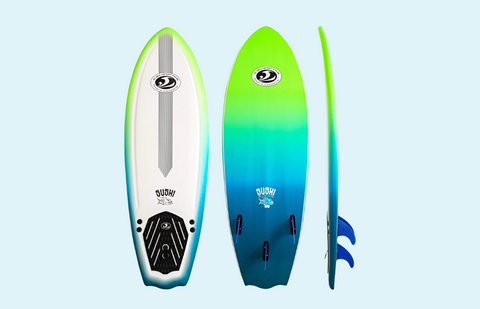
The CBC 5'8" Sushi Foam Surfboard is an agile and versatile board designed for both beginners and experienced surfers. It features a robust EPS core, a wide nose for stability, a round tail for maneuverability, and a shortboard design for quick turns.
Pros:
- Lightweight and sturdy, weighing only 6.5 lbs.
- Enhanced stability and control, suitable for various wave conditions.
- Includes a traction pad and tri-fin system made from durable materials.
Cons:
- Limited weight capacity of up to 160 lbs, which may not suit heavier surfers.
- Shortboard design might be challenging for absolute beginners.
Recommendation:
The CBC 5'8" Sushi Foam Surfboard is highly recommended for surfers looking for a reliable and versatile foam shortboard. It's especially suited for those transitioning from beginner to intermediate levels and seeking a board that can handle a range of conditions. Its lightweight design and maneuverability make it a fun choice for regular surfers.
2. CBC 9' "California 108" Wood Graphic Foam Surfboard
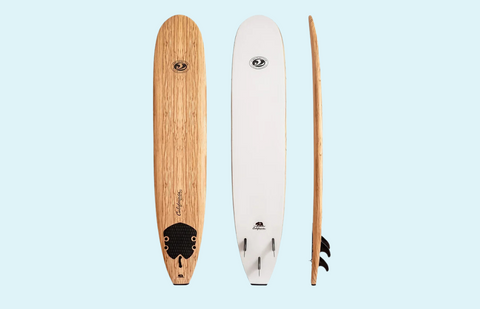
The CBC 9' "California 108" Wood Graphic Foam Surfboard blends aesthetics with performance. This 9-foot board offers ample space for maneuverability and is crafted from high-quality, durable foam with a nostalgic California wood graphic design.
Pros:
- Generous length and volume (91.75L) for stability and buoyancy, ideal for beginners.
- Lightweight (15 lbs) yet sturdy, capable of handling various wave conditions.
- Heat laminated, high-density 100% waterproof EPS core and foam deck, with a slick hard bottom for speed.
Cons:
- A higher price point may not suit all budgets.
- The wooden graphic design, while appealing, may not appeal to all tastes.
Recommendation:
The CBC 9' "California 108" is highly recommended for adult beginners or as a high-quality foam surfboard. It's especially suitable for those seeking a board that combines functionality with a classic look. Its size, construction, and design make it a versatile choice for both learning and enjoying surfing.
3. Good Wave 5'6" Fruities Foam Surfboard - Watermelon
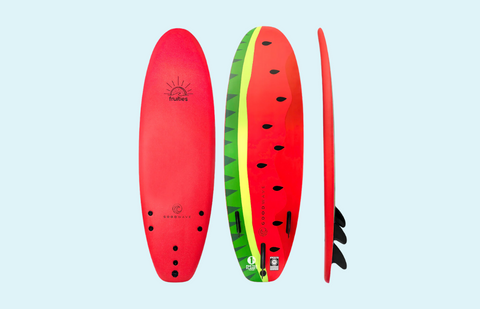
The Good Wave 5'6" Fruities Foam Surfboard - Watermelon is a popular choice for kids. It's designed for stability and confidence-building in the water, with a vibrant watermelon design that adds fun to the learning process.
Pros:
- Lightweight at 7 lbs, encouraging young surfers to handle their gear independently.
- Suitable for a wide range of riders with a weight capacity of up to 154 lbs.
- 47 liters volume providing stability and buoyancy, ideal for beginners.
Cons:
- The specific design may not appeal to all age groups.
- Limited to beginner and intermediate skill levels due to its size and design.
Recommendation:
The Good Wave Fruities Watermelon Surfboard is an excellent choice for families and young beginners. Its engaging design and beginner-friendly features make it a perfect board for building water confidence and learning the basics of surfing. Ideal for young surfers who want a fun and reliable introduction to the sport.
4. CBC 6'2" Sushi Foam Surfboard
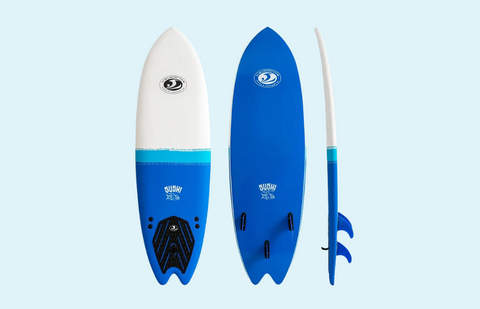
The CBC 6'2" Sushi Foam Surfboard is a top-performing soft top surfboard designed for both beginners and experienced surfers. It features a 100% waterproof foam core, laminated wood stringers for flexibility, and a vibrant graphic on its slick polyethylene bottom.
Pros:
- Ideal dimensions of 6'2" x 22" x 3", with a 43.22L volume, providing a perfect balance of control and buoyancy.
- Lightweight at 7.5 lbs, enhancing maneuverability.
- Enhanced grip with IXPE/XPE deck skin and attached traction pad.
- Includes three surf fins and a PU surf leash for a complete surfing package.
Cons:
- Weight capacity of up to 175 lbs may limit suitability for heavier surfers.
- The specific shortboard design might be challenging for absolute beginners to handle.
Recommendation:
The CBC 6'2" Sushi Foam Surfboard is an excellent choice for young or smaller surfers learning to surf and for heavier, advanced surfers seeking a new challenge. Its combination of durability, performance, and user-friendly features makes it a versatile choice for a wide range of skill levels and surfing styles.
5. CBC 7' California Wood Graphic Foam Surfboard
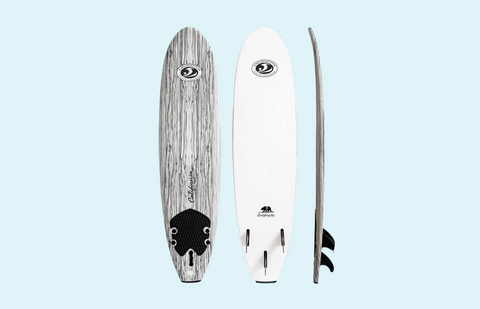
The CBC 7' Classic Wood Graphic Foam Surfboard is a stylish and versatile surfboard for both beginners and experienced surfers. This 7-foot surfboard is designed with a perfect blend of aesthetics and performance, featuring an intricate wood graphic design. It's an excellent option for both novices and seasoned surfers.
Pros:
- Ideal dimensions (7' x 22" x 3.5") and volume (57.24L) for stability and control.
- Durable foam core and streamlined shape, weighing 10 lbs.
- Includes traction pad, tail cap, and easy-to-install tri-fin system for enhanced surfing experience.
Cons:
- The graphic design may not appeal to all surfers.
- Slightly heavier weight compared to smaller foam boards.
Recommendation:
The CBC 7' California Wood Graphic Foam Surfboard is recommended for those seeking a blend of style and functionality. The length and versatile design of this 7-foot surfboard makes it suitable for both learning beginners and skilled surfers looking for a stable yet responsive board. Ideal for children, teenagers, and adults starting their surfing journey.
6. Scott Burke 5'2" Fish Foam Surfboard
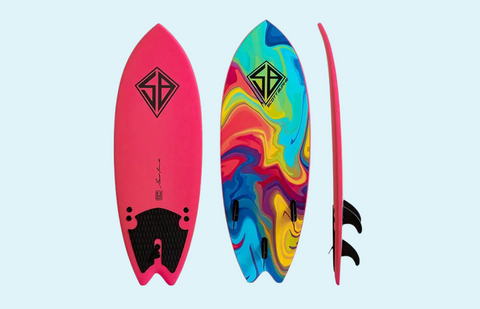
The Scott Burke 5'2" Fish Foam Surfboard is designed for versatility and performance. With its chic, lightweight design and distinctive fish-shaped tail, this board is ideal for both beginners and seasoned surfers.
Pros:
- Compact and maneuverable with dimensions of 5'2" x 21.75" x 2.5" and a volume of 30.18 L.
- Ultra-lightweight at only 5.75 lbs, enhancing ease of handling.
- 100% waterproof EPS foam core ensures buoyancy and durability.
- XPE deck skin provides optimal grip and comfort, along with a slick PE hard bottom for speed.
Cons:
- Limited weight capacity of up to 150 lbs, which may not be suitable for all surfers.
- The fish-shaped tail design may offer a challenge for absolute beginners.
Recommendation:
The Scott Burke 5'2'' Fish Foam Surfboard is an excellent choice for younger surfers or those transitioning from beginner to intermediate skills. It's lightweight, combined with the stability and strength provided by its construction, makes it an ideal board for those looking to enhance their surfing experience.
7. CBC 9'0" Slasher Foam Surfboard
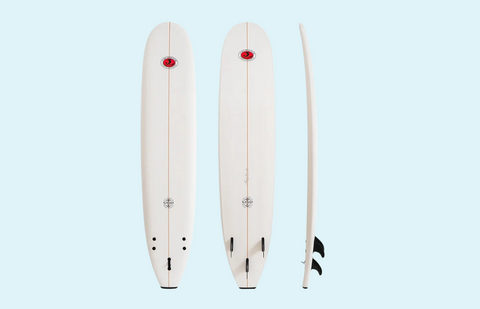
The CBC 9'0" Slasher Foam Surfboard is a versatile and stylish longboard designed for beginner to intermediate surfers. It features a 100% waterproof EPS foam core, laminated wood stringers for flexibility, and a sleek, foam deck with top and bottom graphics mimicking a fiberglass surfboard.
Pros:
- Spacious dimensions of 9' x 24" x 4" and a large volume of 91.75L, ideal for stability.
- Lightweight at 14 lbs, enhancing ease of handling and maneuverability.
- Includes three surf fins and a white leash tab for added control and safety.
Cons:
- Higher price points may not be accessible for all budgets.
- The large size might be cumbersome for absolute beginners or smaller surfers.
Recommendation:
The CBC 9'0" Slasher Foam Surfboard is recommended for those who are new to surfing or transitioning to intermediate levels. Its large size, stability, and buoyant design make it perfect for practicing paddling, catching small waves, and a smoother ride. This surfboard is ideal for family use and surfers looking for a safe yet exciting surfing experience.
8. CBC 5'8" Slasher Fish Foam Surfboard Soft Top

The CBC 5'8" Slasher Fish Foam Surfboard Soft Top offers a balance of performance and convenience. Tailored for all skill levels, this surfboard provides a steady, enjoyable ride. Its design and material ensure buoyancy and grip, with a fish shape for speed and controlled turns.
Pros:
- Compact dimensions (5'8" x 22" x 2.75") and a volume of 38.8L, ideal for control and maneuverability.
- Very lightweight at 6 lbs, making it easy to carry and handle.
- Heat-laminated, high-density EPS foam core ensures durability and waterproofing.
- Comes with three fins and a leash tab for added functionality.
Cons:
- Weight capacity is limited to 150 lbs, restricting its suitability for heavier surfers.
- The shortboard design might be challenging for absolute beginners.
Recommendation:
The CBC 5'8" Slasher Surfboard is a great option for young or lightweight riders, or more advanced adult surfers looking for a shortboard experience. It combines safety and performance, making it an ideal starter board for youngsters post-surf lessons or a fun, performance-oriented option for adults.
9. CBC 5'2" Slasher Fish Foam Surfboard Soft Top
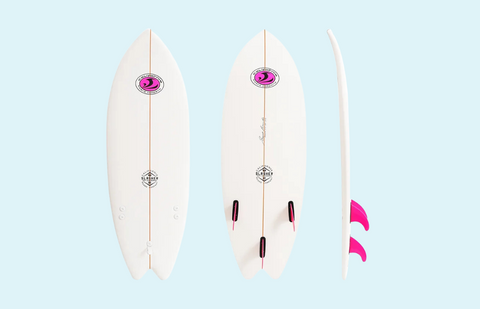
The CBC 5'2" Slasher Fish Foam Surfboard Soft Top offers a unique blend of design and functionality for surf enthusiasts. This board is known for its fishtail and sturdy rails, providing top-speed surfing and high control, making it ideal for catching and cruising on waves.
Pros:
- Compact size (5'2" x 22" x 2.5") and lightweight (6.4 lbs) for exceptional maneuverability.
- The 100% waterproof EPS foam core, high-density PE slick bottom, and IXPE/XPE deck skin offer unrivaled performance in water.
- Comes with three matching easy-to-install pink surf fins and a hidden white leash tab.
Cons:
- Weight capacity is up to 150 lbs, limiting its use for heavier surfers.
- The specific fish design may not be suitable for beginners who need more stability.
Recommendation:
The CBC 5'2" Slasher Fish Foam Surfboard is an excellent choice for surfers seeking a light, agile board with a distinctive design. It's particularly suited for intermediate to advanced surfers looking for a surfboard that can handle quick maneuvers and fast waves. While not the best pick for beginners, it's an ideal board for those progressing in their surfing skills.
10. CBC 8' California Foam Surfboard
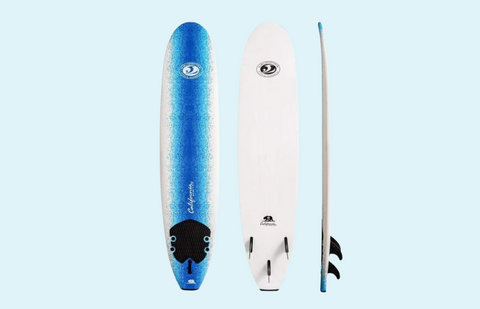
The CBC 8' California Foam Surfboard combines classic style with functionality. It's designed for surfers of all ages and skill levels, offering a blend of safety, durability, and performance.
Pros:
- Generous dimensions (8' x 23" x 3.75") and 73.27L volume provide stability and buoyancy.
- Durable with a heat-laminated high-density waterproof EPS core and foam deck.
- Lightweight at 13.5 lbs for easy handling.
- Comes with 3 surf fins, a PU surf leash, and a preinstalled traction pad.
Cons:
- The large size might be unwieldy for very young or small surfers.
Recommendation:
The CBC 8' California Foam Surfboard is ideal for beginners to intermediate surfers seeking a reliable and stylish board. Its size and volume make it a great choice for those learning to surf, providing a stable platform for catching waves. It's also suitable for casual surfers who prioritize ease of use and aesthetic appeal.
Surfboard Size and Shapes
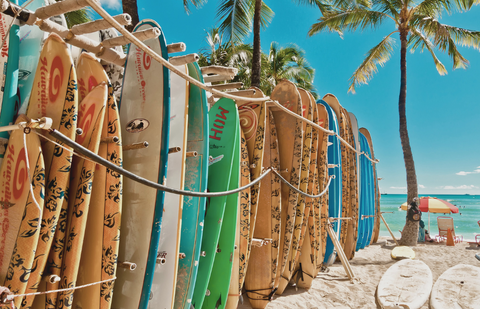
When starting surfing, one of the most important choices for a beginner is picking a surfboard with the correct size and shape. This decision greatly affects how easy it is to learn and the whole experience of surfing.
Understanding the Importance of Size and Shape
- Size Matters:
- Length: A longer surfboard offers more stability and is easier to paddle, making it ideal for beginners. It provides a larger surface area, which helps in maintaining balance.
- Width and Thickness: A wider and thicker board adds to the buoyancy, making it easier to catch waves. This is especially beneficial for beginners who are mastering the art of paddling and wave timing.
- Shape Influences Performance:
- Rounded Shapes: These shapes are especially forgiving and stable, making them an excellent choice for beginner surfers. The gentle curves of rounded surfboards offer a smoother ride, which is beneficial in helping new surfers maintain balance and gain confidence.
- Pointed Nose Surfboards: More suited to the experienced surfer, these boards are designed for executing sharper turns and precise wave navigation. However, for those new to surfing, the pointed nose can be challenging, as it requires a higher level of skill to manage the quick maneuvers and maintain stability. This makes them less ideal for beginners who are still mastering the basics of surfing.
Choosing the Right Dimensions
- Beginner Surfers:
- Ease of Use: A longer, wider, and thicker surfboard is generally recommended for those just starting. These dimensions provide the necessary stability and buoyancy.
- Optimal length: Surfboards around 7 to 9 feet long are typically suggested for beginners, depending on their height and weight.
- Considerations for Individual Needs:
- Height and Weight: Your physical attributes play a significant role in determining the appropriate surfboard size. A taller or heavier individual may require a larger board for adequate support.
- Fitness Level and Swimming Ability: Beginners with a strong swimming background or good fitness level might progress quicker and thus consider slightly shorter boards.
Choosing the right size and shape of a surfboard is a fundamental step in a beginner surfer's journey. It's about finding a balance between stability and the ability to progress skills. Remember, the right surfboard is the one that feels comfortable and instills confidence as you ride the waves.
Smart Purchasing: Tips for Buying Beginner Surfboard
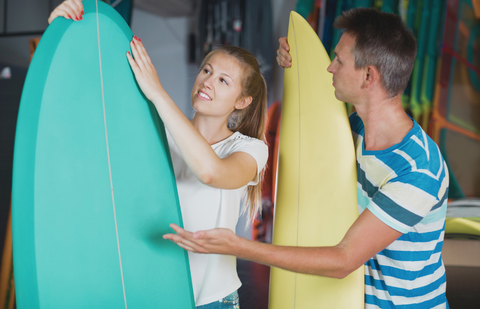
Surfing begins with purchasing your first surfboard. This decision is both exciting and important, as the right surfboard can enhance your learning experience. Here are some essential tips to help make an informed choice when buying a beginner surfboard.
Understanding Your Needs
- Skill Level: Consider your current skill level. Beginners should look for surfboards that offer stability, buoyancy, and ease of handling.
- Body Type: Choose a board that suits your height and weight. A board that's too small might not provide enough floatation, while one that's too large may be difficult to control.
Types of Surfboards
- Foam Boards: Often recommended for beginners due to their safety, stability, and affordability.
- Longboards: Ideal for learning the basics and catching small waves.
- Funboards: A good middle ground for those who want to transition from a longboard to a shorter board.
Quality and Budget
- New vs. Used: Decide whether to buy a new or used surfboard. New boards will be in perfect condition but more expensive. Used boards can be more affordable but require careful examination for any damage.
- Price Range: Set a realistic budget. The most expensive surfboard is not necessarily the best for a beginner.
Check for Durability and Maintenance
- Construction Material: Epoxy boards are known for their durability and lightweight, making them a good choice for beginners.
- Maintenance: Consider the maintenance requirements of the surfboard. Foam boards, for example, require less maintenance compared to fiberglass boards.
Conclusion
Starting your surfing adventure is an exciting journey, and picking the right surfboard is the first step. Whether you opt for a longboard, a soft top, or a used board, the key is finding a surfboard that aligns with your beginner needs - stability, buoyancy, and ease of use. Embrace the journey with patience and enthusiasm. Every wave brings a new learning opportunity. With the right board under your feet, the ocean is yours to explore and enjoy.
Frequently Asked Questions for Beginner Surfers
What Type of Surfboard is Best for Beginners?
Beginners should opt for surfboards that offer stability and ease of paddling. Longboards and foam surfboards are often recommended because they are longer and wider, providing a stable platform for learning. The material is also crucial; foam surfboards are lightweight, durable, and safer for beginners.
Is it Better to Start with a Soft-Top or Hard-Top Surfboard?
For beginners, soft-top surfboards are generally better. They are safer, more buoyant, and offer a gentler introduction to surfing. Hard-top surfboards can be used by beginners but usually require a bit more skill and balance.
How Do I Know if a Surfboard Matches My Ability?
The best approach is to consult with experienced surfers or instructors, especially at a surf shop. They can provide advice based on your size, fitness level, and surfing goals. Trying different boards can also give you a sense of what suits you best.
What are Some Common Mistakes to Avoid When Choosing a Surfboard for Beginners?
Avoid choosing a board that's too advanced for your skill level. Ensure the board is appropriate for your body size and weight, and consider the typical wave conditions where you'll be surfing. Beginners often overlook these factors, which are crucial for a good learning experience.
How Do I Know What Size Surfboard to Get for Beginners?
Your height and weight are significant factors in determining the appropriate surfboard size. Generally, a taller or heavier beginner might need a larger board. The volume of the surfboard, measured in liters, indicates its buoyancy and should match your body weight.
How Many Liters Should a Beginner Surfboard Be?
A good rule of thumb is 1 liter of volume for every 1 kilogram of body weight. For instance, a 70 kg beginner might start with a board that has around 70 liters of volume. However, this can vary based on fitness level and the type of waves you'll be surfing.
What is the Easiest Surfboard to Catch Waves On?
Longboards and foam boards are usually the easiest for beginners to catch waves on. Their size, volume, and buoyancy make paddling and wave-catching more manageable.



